Zotac ZBOX MAGNUS EK71080 Compact Gaming PC Review
by Ganesh T S on March 28, 2018 8:00 AM ESTPower Consumption and Thermal Performance
The power consumption of the Zotac ZBOX MAGNUS EK71080 at the wall was measured with a 4K display (LG 43UD79B) being driven through one of its DisplayPort outputs. In the graphs below, we compare the idle and load power of the system with other high-performance SFF PCs that we have evaluated before. For load power consumption, we ran our own custom stress test (Prime95 and FurMark) as well as the AIDA64 System Stability Test with various stress components, and noted the maximum sustained power consumption at the wall.


Our configuration of the EK71080 has the highest idle and load power consumption numbers amongst all the -H series and lower TDP CPU-equipped systems. In fact, the EK71080's numbers are surpassed only by the systems with the 65W desktop CPUs.
Our thermal stress routine starts with the system at idle, followed by four stages of different system loading profiles using the AIDA64 System Stability Test (each of 30 minutes duration). In the first stage, we stress the CPU, caches and RAM. In the second stage, we add the GPU to the above list. In the third stage, we stress the GPU standalone. In the final stage, we stress all the system components (including the disks). Beyond this, we leave the unit idle in order to determine how quickly the various temperatures in the system can come back to normal idling range. The various clocks, temperatures and power consumption numbers for the system during the above routine are presented in the graphs below.
We repeated the same observations with our legacy stress test using the latest versions of Prime95 and Furmark.
The EK71080 was able to get through our thermal stress routines without any issues. The core temperatures were held below 95C even under extreme stress. The only minor concern is the SSD temperature. The M.2 SSD has a fan on its side, but, it doesn't prevent the SSD from reaching as high as 80C.



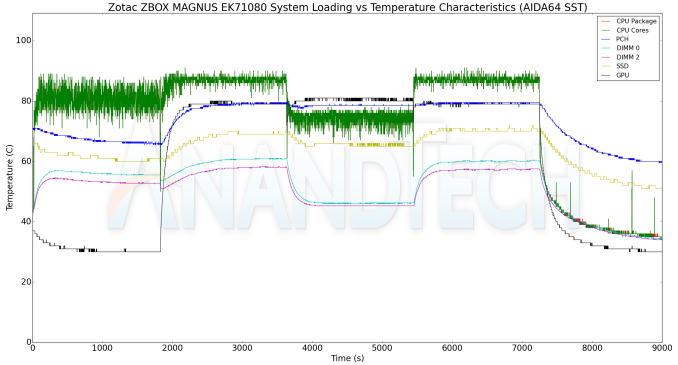
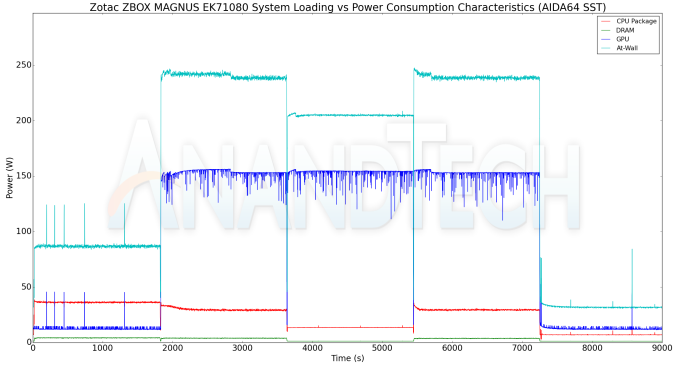
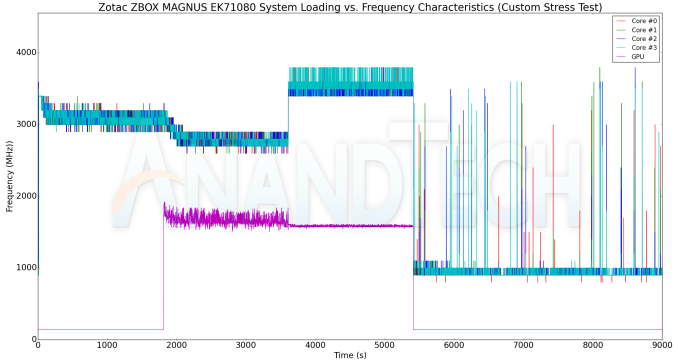
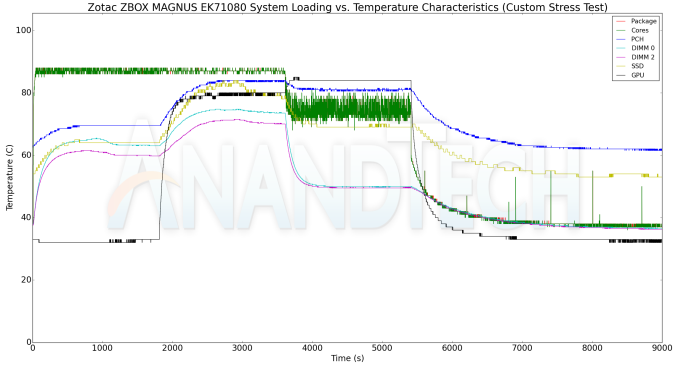
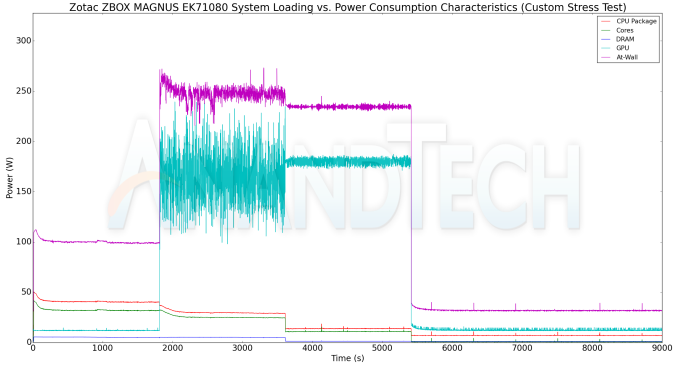








17 Comments
View All Comments
The_Assimilator - Wednesday, March 28, 2018 - link
Would be nice to see pictures of the graphics card and how it connects to the motherboard, HINT HINT.And... am I the only one who thinks this unit is oriented the wrong way up? That exploded diagram Zotac provided show the CPU and graphics card drawing cool air in from the top of the case - but as we know, hot air rises, so what's gonna happen (to my thinking at least) is that the hot exhaust air is going to rise and get pulled back into the system, and go round and round and round...
Surely the cooling would work better if the unit was upside down, allowing the CPU and GPU to pull in cool air from the bottom and exhaust it higher up so it can rise? I'm assuming Zotac tested this, but it would be fun for AnandTech to confirm whether I'm crazy or not.
JoeyJoJo123 - Wednesday, March 28, 2018 - link
Natural convection is such a weak force that it only matters for completely passively cooled systems. Forcibly exhausting warm air outside the case is a vastly stronger option for removing heat and the orientation of where it's directing heat (up, side, down, or whatever) has no bearing on the effective heat dissipation, regardless of whether it's in line with natural convection or the opposite direction, so long as the exhaust isn't being pointed in a direction that blocks the air (ex: single exhaust fan pointing downward on a midtower sitting 1" off the carpet floor, the exhaust won't be able to remove air since there is a barrier on the other side)Simply put, convection doesn't matter in PC systems with fan intakes/exhausts.
vailr - Wednesday, March 28, 2018 - link
Is that GTX 1080 a mobile or desktop GPU? How is it cooled?From the photos, it looks like some kind of custom desktop GPU type of card, with 1x DVI, 1x HDMI & 3x DP ports, with the GPU chip on the under side of the card (?). Which would be less effective as a cooling solution, compared with the GPU and it's cooling fan on the top side: heat rises.
ganeshts - Wednesday, March 28, 2018 - link
It is a desktop GPU configured with a 175W TDP (as evident from the power component in the thermal stress section).I don't believe this is a custom card, just the ZOTAC GeForce GTX 1080 Mini with a different fan configuration. The display outputs at the back match exactly with the card used in the EK71080.
guidryp - Saturday, March 31, 2018 - link
Do you guys not have a PC with desktop GPU to provide at least one such comparison.It would be useful to know, how much performance you are giving for the tiny form factor.
Hixbot - Wednesday, April 4, 2018 - link
I really think noise levels should be compared in all these SFF reviews.modport - Friday, April 6, 2018 - link
I'm looking into pre-built more minimal looking (to put it nicely) gaming mini PCs. Noise level is definitely a factor. It'd be nice to compare actual dBA levels.rima1 - Friday, April 6, 2018 - link
Uncommon work! Each and every one of you finish a stunning web journal, and have some exceptional substance. Continue doing dazzlinghttp://carmelflowers.net/
keralataxi - Thursday, May 31, 2018 - link
The details about power your play is new to us.I am so thankful to you for added my knowledge.http://keralatravelcabs.com/tempo-traveller-taxi-s...
bestessay1 - Friday, April 6, 2018 - link
All I can express that I genuinely savored the experience of breaking down this stunning post.http://myessaypapers.net